There are many historical monuments in Madrid that you can learn about from the past of different cultures that will change the way you see the world. Located in the center of the Iberian Peninsula, Madrid is the largest city in Spain. With a population of over 3.3 million, the city is best known for its cosmopolitan nature. The city provides a wide range of things to do, places to eat and it has all the facilities that a tourist needs. The city provides many conference resorts, leisure facilities and some of the best restaurants in Spain. It is also a great place for shopping, theatre, opera, museums, parks and more. It truly opens up your eyes. It truly opens up your eyes. While you are visiting their most important monuments in Madrid, it is one of the best ways to learn about local history. This city of Spain has great weather if you are planning to visit this country you must go through its monuments where you can get an insight into the local culture and history.
List of Monuments in Madrid
1. Puerta del Sol

Puerta del Sol
Puerta del Sol is also called the Gate of the sun in Spanish. It is one of the busiest and most popular public squares in the city of Madrid. This is considered to be the center of the radial network of roads in Spain. Along with a large clock, it features many popular attractions. Puerta del Sol is referred to as the official central point in the city of Madrid. In its earlier days, it used to be the eastern gate of the city and now it is much more than that. This famous landmark in Madrid is home to the famous clock tower, “Real Casa de Correos”, whose bells mark the beginning of a new year.
The tower was first built as a part of the Post Office which is now the headquarters of the President of Madrid’s autonomous community. Visiting this place during Christmas or New Year is considered to be the best time and it is also broadcasted live on the television. The official symbol of the city is the Oso y Madrono statue, and the Calle Alcala and the equestrian statue of Carlos III, the other major attractions in this square.
Address: Puerta del Sol, 28013 Madrid Spain.
Read More: Monuments in Hong Kong
2. Chamberi Ghost Station
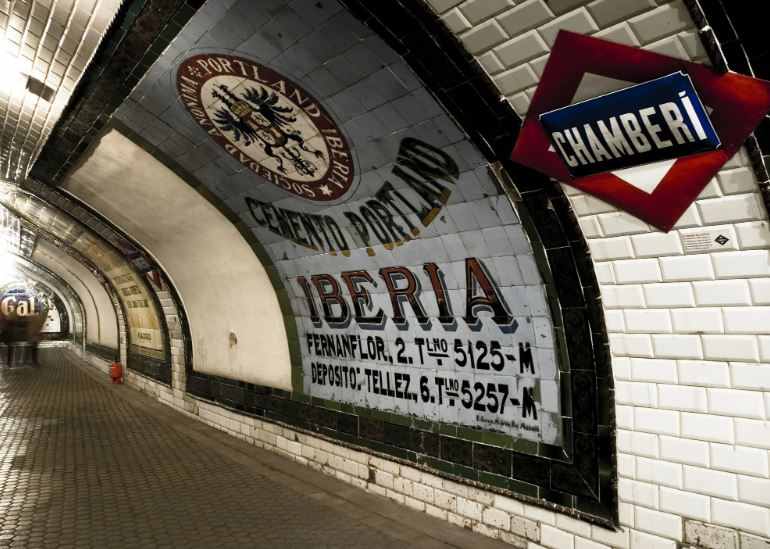
Chamberi Ghost Station
Inspired by the brightly colored stations of Paris, the Chamberí station was inaugurated as part of Madrid’s first metro line in 1919. In 1966 it fell into permanent disuse being converted into a museum in 2008 as it remains today. With the progression of time, the metro carriages in the Madrid organization were protracted, and the stations expected to adjust to this new size. The main attraction of this popular monument in Madrid, however, is found in the beautifully reconstructed original ads lining the walls of the platform, composed of tiny, brilliantly-colored tiles just as they were in 1919. Separated from the exhibit area only by a clear glass barrier so just don’t be startled by the trains that still rumble through this abandoned-station-turned-museum.
Address: 38-40 Calle de Luchana, Madrid, 28010 Spain.
3. Plaza de la Villa

Plaza de la Villa
The Plaza de la Villa, located in the historic center of the city of Madrid, is situated next to the main street. Three small streets originated from it that corresponded to the medieval layout of the city. Around its main facades, there are buildings of great historical value built. The oldest among them is the House and Tower Lujanes. One of the oldest plazas in Madrid, the Plaza de la Villa is a small plaza which is bounded by some of the best historically important monuments in this city. The plaza was constructed during the Austrian Hapsburg Dynasty which led to this name. Though it is smaller than all its neighboring plazas, it has the most charm in itself. This important monument in Madrid is surrounded on three sides by the 15th century Torre de Los Lujanes, Ayuntamiento and the Casa de Cisneros, while the fourth side opens to Calle Mayor. Nowadays, it has a large ornamental garden surrounding it.
Address: Plaza de la Villa, Madrid, Spain.
Read: Famous Monuments in Benin
4. Reina Sofía Museum
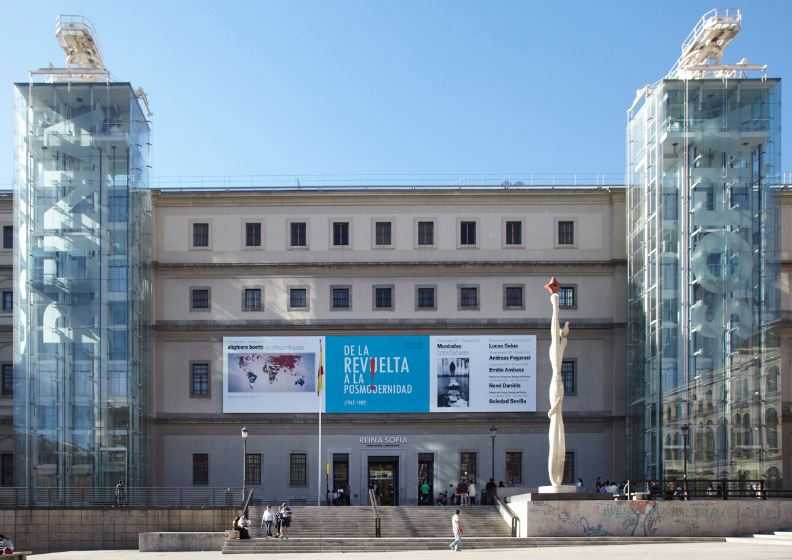
Reina Sofía Museum
Founded in 1992 also known as Museo Nacional Centro de Arte Reina Sofía, the Reina Sofía Museum is an iconic monument in Madrid with one of the finest collections of Spanish contemporary art and one of the most visited museums. This place is heaven for art fans and an essential part of Madrid’s Art Triangle, together with the Prado and Thyssen-Bornemisza museums. Occupying an immense, slab-sided building, the Reina Sofía boasts an impressive façade with glass and steel lift-shafts, designed by British architect Ian Ritchie. Nowadays, the museum is just as impressive from the back, with three buildings, principally built of glass and steel, arranged around a courtyard and all covered by a triangular, the work of French architect Jean Nouvel and zinc-and-aluminium roof. This ambitious extension project adds almost 30,000 sq m to the already vast art space in the patio to the south-west of the main edifice. It includes temporary exhibition spaces.
Address: Calle de Santa Isabel, Madrid, Spain.
5. Plaza de Cibeles
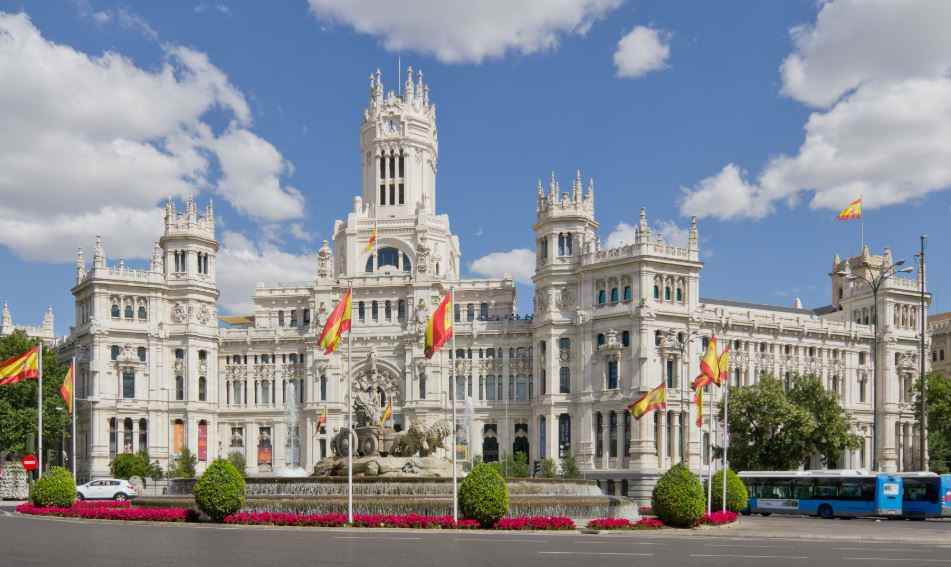
Plaza de Cibeles
Considered as one of the famous landmarks of the city, Plaza de Cibeles is a square which has a neo-classical complex of marble sculptures and fountains. It is situated at the intersection point of Paseo de Recoletosa and Paseo del Prado, and Calle de Alcala. There are four marvelous buildings that dominate the square: The Bank of Spain, the Palacio de Linares, the Palacio de Buena vista and the Cybele Palace. The Cibeles fountain is now considered to be the icon of Madrid. This important monument of Madrid is located in the heart of the city and it portrays the Greek goddess of fertility and nature, Cybele, sitting on a chariot holding a scepter along with a key, who is being pulled by two lions. The pull of wild lions signifies the power of the goddess or of nature. It was designed by Ventura Rodriques in 1782. Some say that the source of this fountain goes back to the times when Madrid was a Moorish settlement. Real Madrid football team has unofficially adopted the fountain and they use it as a meeting point for its fans when they win a cup.
Address: Calle Alcala and Paseo de Recoletos, Madrid Spain.
Read More: Monuments in Belize
6. Plaza Mayor

Plaza Mayor
The Plaza Mayor in the city of Madrid is also known as the Central Plaza. It was built during the reign of Philip III. Located nearby the Puerta del Sol, the Plaza Mayor is rectangular in shape surrounded by three storeyed residential buildings. Built during the reign of King Philip III, the Plaza Mayor is dominated by the Casa de la Panaderia and it is also the Plaza Mayor is the central plaza of the city. This grand arcaded square is located near the Puerta del Sol. Along with the vibrant street life, it is one of the best places to witness the architectural grandeur of the city around it. The Casa de la Panaderia is the most predominant building in the square and it is a municipal and a cultural building. It is four floors high and there is a Spanish coat of arms. This famous monument in Madrid also holds various traditional shops and eateries in its vicinity. There is a bronze statue of King Philip III at the centre of the square.
Address: Plaza Mayor, 28012 Madrid, Spain.
7. Prado Museum

Prado Museum
The Prado Museum is one of the most important art museums in the world. This important historical landmark in Madrid was designed by Juan de Villanueva and was inaugurated in 1819. Its art collection is based mainly on sixteenth to twentieth-century artwork and includes masterpieces by painters like Velázquez, El Greco, Rubens, Bosch, and Goya. There is obviously a large collection of Spanish art works as would be expected and it remains an extraordinary experience to see these art works in the flesh” that have graced pages of art books and websites. There is an extensive gift shop which has a very nice range of art-related offerings across the full spectrum from art books for the aficionados to art-related items more suited to the general visitor.
Address: Calle Ruiz de Alarcon, Madrid, Spain.
Read More: Monuments of Toronto
8. Gran Vía

Gran Vía
Gran Via is one of those streets which has the most happening nightlife in Europe also known as Spanish Broadway. The street is ornamented with numerous clubs, hotels, theatres and shopping centres. It also showcases the early 20th-century architecture of Spain. Gran Via, the most famous street in the city of Madrid has been mentioned in a lot of books and zarzuelas(Spanish operettas) as well as showcased in numerous films. The street begins from the Plaza de Alcala square and continues to connect the Plaza de Espana. This amazing landmark in Madrid in literal terms is referred to as a great way and it is home to numerous business shops, banks, hotels, bars, restaurants and theatres. It is one of the most crucial commercial districts in Madrid. It is a must to walk along the street and gaze at these rooftops of the impressive buildings as most of them are decorated lavishly and have large statues perching on the ledge of the top. A few important buildings include Edificio Metropolis at the corner of Calle Alcala and the Telefonica building, which is the tallest skyscraper in Madrid.
Address: Street Gran Via, 28013 Madrid Spain.
9. Royal Palace
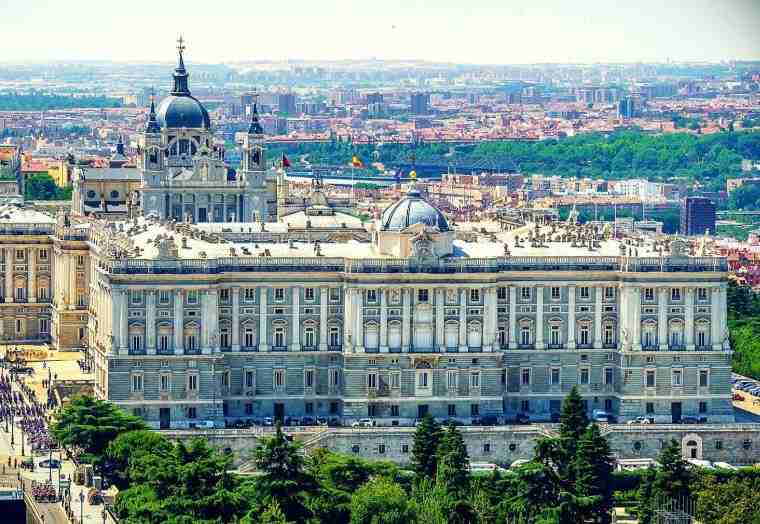
Royal Palace
The Royal Palace of Madrid or Palace Real is the official residence of the Royal Highness of the city of Madrid. Though King Felipe VI did not reside in that palace and chose Palacio de la Zarzuela as their residency. Palacio Real is now used only for state ceremonies. The palace is located on Bailen Street and is easily accessible from Opera metro station. Palacio Royal is the largest building in Madrid that refers to the Royal Palace of Madrid. This beautiful monument in Madrid is not the official residence of the king, yet all the major ceremonies take place here. It is also referred to as the Palacio de Oriente sometimes is located close to Plaza de Oriente square. the origin of this dates backs to the times when the Alcazar castle was built here during the 16th century when the Muslim Kingdom ruled in Toledo. The current palace was built when King Felipe V decided to build a palace for his Borbon dynasty during the period of 1738 and 1755. The palace now contains furniture, paintings, ceramics and tapestries which attract visitors from all over the world.
Address: Calle de Bailén, s/n, 28071 Madrid, Spain
Read More: Monuments of Botswana
10. Temple of Debod

Temple of Debod
The Temple of Debod is one of Madrid’s hidden treasures and one of the monuments to see in Madrid. It sits to the west of Plaza de España, in the Parque del Oeste. This popular ancient monument in Madrid is from the second century B.C. and by the Egyptian state for helping save the Abu Simbel temple was donated to Spain, as well as from being buried under the construction of the Aswan High Dam other monuments and archaeological sites.
Address: Calle de Ferraz, 1, 28008 Madrid, Spain.
11. Catedral de la Almudena
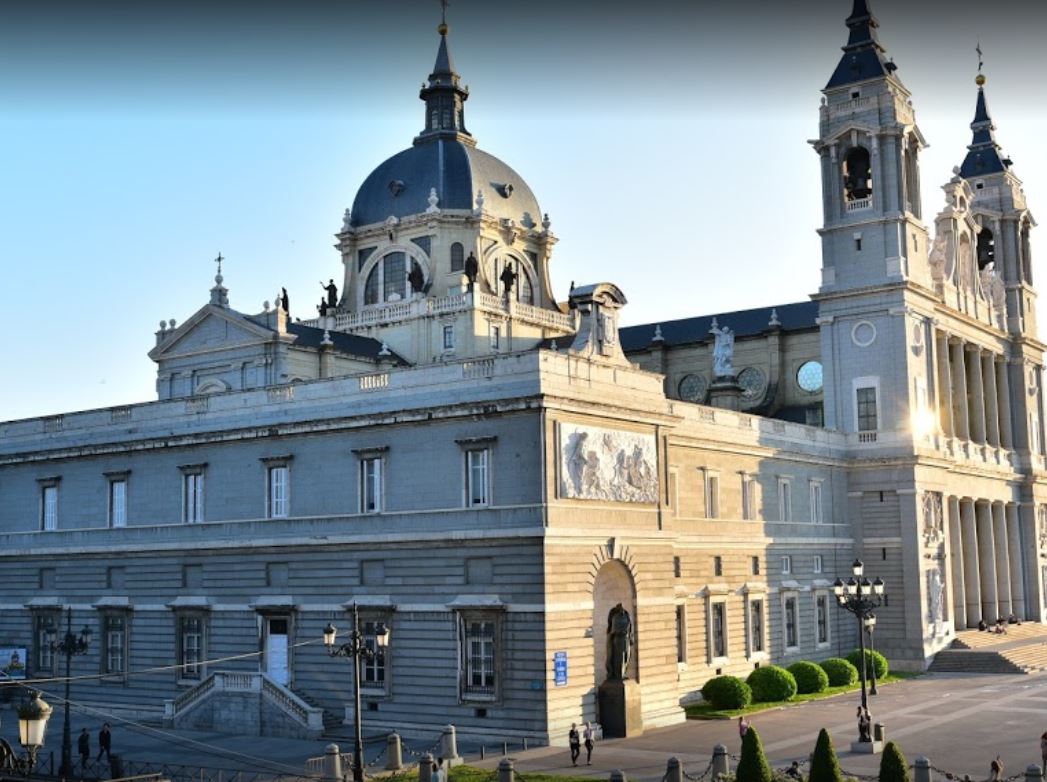
Catedral de la Almudena
The seat of the Roman Catholic Archdiocese of Madrid, Santa Maria la Real de La Almudena is a Catholic Cathedral located in Madrid. It was consecrated in 1993 by Pope John Paul II. It seems that this religious monument in Madrid had been built on a medieval mosque site that was destroyed when Alfonso VI conquered Madrid. The construction of this cathedral started in 1883, and it continued till 1993 and it is now the principal church in the Diocese of Madrid. For the new capital, King Felipe II wanted a cathedral when it was transferred from Toledo to Madrid. The site on which the cathedral is built was originally the site of the first mosque of Madrid. The cathedral was designed by Francisco de Cubas in a gothic revival style. The interior of the cathedral is bright and is designed in the Neo-Gothic style which is modern, with a touch of contemporary art. The major attractions here include Neo-Romanesque Crypt and a museum that explains the history of the church and the archdiocese of Madrid.
Address: Calle de Bailén, 10, 28013 Madrid, Spain.
Read More: Monuments of Zurich
12. Neptune Fountain

Neptune Fountain
Designed as part of the three sculptural monuments, the Neptune Fountain was created by Ventura Rodríguez for the Paseo del Prado, in addition to the Cibeles Fountain and the Apollo Fountain. It was designed during 1777 and its construction began in 1782 and finished in 1786. This beautiful neoclassic monument was sculpted in white marble and is located in Plaza de Cánovas del Castillo, commonly known as Plaza de Neptuno. The fountain is surrounded by amazing buildings from the eighteenth and nineteenth centuries. There is a huge sculpture of Neptune, the God of the sea pon the circular base of the fountain holding a trident while riding a carriage moved by two horses. This beautiful monument in Madrid is an emblematic place for the fans of the soccer team Atlético de Madrid, since they celebrate the victories of their Spanish team there.
Address: Plaza Cánovas del Castillo, Madrid, Spain.
13. Plaza España
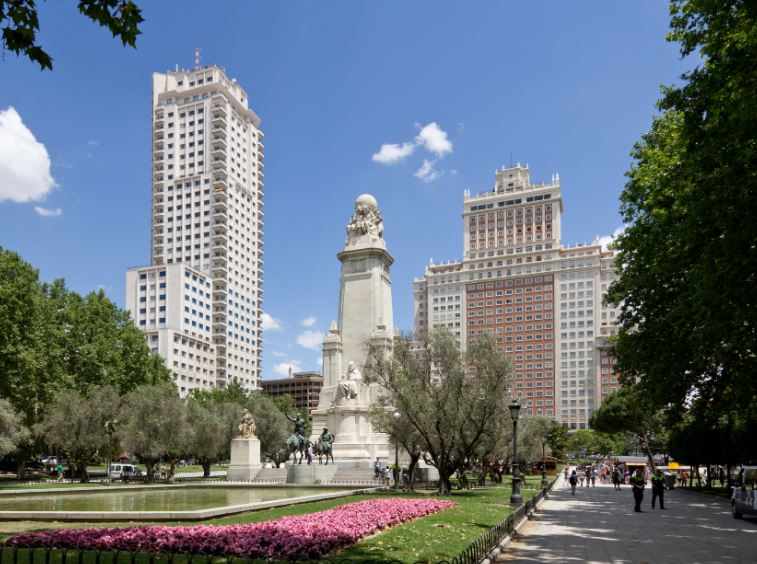
Plaza España
This iconic landmark in Madrid named Plaza de España of Madrid is a big square located in the old part of the city in the neighbor of Argüelles. Plaza de Españas links Gran Vía and Calle de la Princesa. Before the construction of Gran Vía, the square was called Plaza de San Marcial. This square is surrounded by remarkable and historical buildings. Most of them are the highest constructions in this Spanish city. First, there is Torre de Madrid, built during 1954 and 1957 by the Otamendi Machimbarrena brothers, who wanted the building to have 500 stores, galleries and even a cinema. In addition, there is Edificio España, which was built in 1953. It has 25 floors and it is 384 feet tall. Casa Gallardo is another important structure located near Plaza de España and is one of the few monuments of modern architecture in Madrid. It was built during 1911 and 1914 by Federico Arias Rey. Finally, there is the building of Real Compañía Asturiana de Minas built during 1891 and 1899 by Manuel Martínez Ángel.
Address: Plaza de España, 28008 Madrid, Spain.
Read More: Monuments in Bulgaria
14. El Retiro Park

El Retiro Park
El Retiro or the Buen Retiro Park is one of the largest parks in the Madrid city belonging to the Spanish Monarchy till the late 19th century. This historic landmark in Madrid is filled with monuments, sculptures, galleries, lakes and hosts a lot of events covering a large area. The park is surrounded by the main city on all sides. Abode to over 15,000 trees, the El Retiro Park is one of the biggest parks in Madrid covering an area of 125 hectares. The park has some of the most important gardens namely the Jardines de Cecilio Rodriquez, the Jardin de Vivaces, the Rose Garden, the Jardines del Arquitecto Herrero Palacios and the Parterre Frances. Earlier, it was owned by the Spanish Monarchy until the late 19th century when the park became open to the public. It is the place to indulge in leisure, cultural and sports activities and it is also popular for its architecture, history and the famous lake. Glass and Velaquez are two palaces which are used as exhibition halls.
Address: Plaza de la Independencia, 7, 28001 Madrid, Spain.
15. Bullring of Las Ventas

Bullring of Las Ventas
Visit this interesting landmark in Madrid named Bullring of Las Ventas, get to know its history and discover all the anecdotes that have been lived in this emblematic Bullring. Walk-in this legendary arena, explore the tiers where emotion is lived and observe the Royal Stage and the Presidency balcony. Enjoy the beautiful Neo-Arabic architecture and observe the 50 ceramics that represent the Spanish provinces. Hear all about the rituals that have captivated a nation from experts, in your own language. Start your visit at the Puerta Grande, covered with plaques and tributes that tell the story of past glories and inspire matadors from Spain and around the world. From there you will enter the laying, the stands where the public is witness to the action. Then you will descend to the most important part of the bullring, the arena. Look at the square from this place and understand the adulation that a bullfighter has and the nerves of feeling 24,000 people screaming. Discover the guts of the square, the corridors, and the infirmary. Is an unforgettable experience that is deep-rooted in every Madrilean. Whether you agree or disagree with bullfights, no one can deny its deep connection to the Spaniard culture.
Address: Calle de Alcalá, 237, 28028 Madrid, Spain
So far we have discussed the best monuments in Madrid, which contains the proper information regarding all the most visited monuments in Madrid. I hope you might have loved reading this article and if you love to know more about Madrid then kindly head to our other articles as well which will help you to get knowledge about Madrid.
The post Most Visited Monuments in Madrid | Famous Monuments of Madrid appeared first on World Tour & Travel Guide, Get Travel Tips, Information, Discover Travel Destination | Adequate Travel.